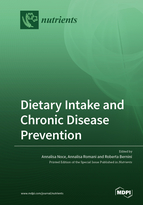Dietary Intake and Chronic Disease Prevention
A special issue of Nutrients (ISSN 2072-6643). This special issue belongs to the section "Nutritional Epidemiology".
Deadline for manuscript submissions: closed (20 December 2020) | Viewed by 71741
Special Issue Editors
Interests: nutrition in chronic kidney disease; haemodialysis; natural active compounds for prevention of non-communicable diseases; body composition assessment; uremic sarcopenia; oxidative stress; microbiome in CKD
Special Issues, Collections and Topics in MDPI journals
Interests: polyphenols characterization and analysis, natural antioxidants, food quality and food supplement, green technologies in food productions, oxidative stress and diet, natural active compounds, in vitro and in vivo antioxidants, antimicrobial and free-scavenger activity
Special Issues, Collections and Topics in MDPI journals
Interests: organic chemistry; natural products chemistry; pharmaceutical chemistry; green chemistry; natural and synthetic biologically active compounds; dietary bioactive compounds; antioxidants
Special Issues, Collections and Topics in MDPI journals
Special Issue Information
Dear Colleagues,
chronic diseases, in particular non-communicable diseases (NCDs) (diabetes mellitus, cardiovascular diseases, cancer, chronic respiratory diseases, and chronic kidney disease), are one of the major causes of mortality and morbidity worldwide. It is estimated that 6 out of 10 people are affected by an NCD, and 4 out of 10 suffer from at least two of them. NCDs present various risk factors that can be classified as nonmodifiable and modifiable. The former includes genetics, gender, and age. The latter are mainly represented by an unhealthy lifestyle such as inadequate caloric intake, lack of physical activity, alcohol abuse, smoking and environmental toxicity. All these risk factors can cause metabolic alterations, which in turn can lead to the onset of NCDs. Thus, NCDs are strongly influenced by lifestyle. In fact, unhealthy eating habits and physical inactivity increase their onset, influencing their progression. A healthy lifestyle exerts a protective effect against onset and progression of NCDs, increasing the life expectancy of subjects.
Prof. Annalisa Noce
Prof. Annalisa Romani
Prof. Roberta Bernini
Guest Editors
Manuscript Submission Information
Manuscripts should be submitted online at www.mdpi.com by registering and logging in to this website. Once you are registered, click here to go to the submission form. Manuscripts can be submitted until the deadline. All submissions that pass pre-check are peer-reviewed. Accepted papers will be published continuously in the journal (as soon as accepted) and will be listed together on the special issue website. Research articles, review articles as well as short communications are invited. For planned papers, a title and short abstract (about 100 words) can be sent to the Editorial Office for announcement on this website.
Submitted manuscripts should not have been published previously, nor be under consideration for publication elsewhere (except conference proceedings papers). All manuscripts are thoroughly refereed through a single-blind peer-review process. A guide for authors and other relevant information for submission of manuscripts is available on the Instructions for Authors page. Nutrients is an international peer-reviewed open access semimonthly journal published by MDPI.
Please visit the Instructions for Authors page before submitting a manuscript. The Article Processing Charge (APC) for publication in this open access journal is 2900 CHF (Swiss Francs). Submitted papers should be well formatted and use good English. Authors may use MDPI's English editing service prior to publication or during author revisions.
Keywords
- Chronic non-communicable diseases (NCDs)
- Mediterranean diet
- DASH diet
- Caloric restriction diet
- Polyphenols, natural antioxidants, diet, and prevention of NCDs
- Food supplement and prevention of NCDs
- Low protein diet
- Gut microbiota
- Paleo diet








